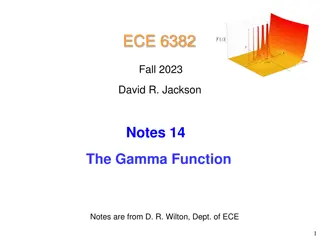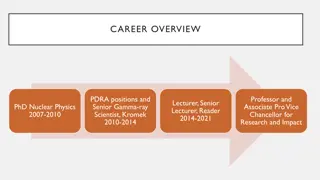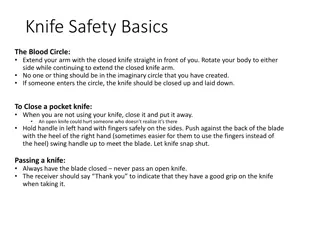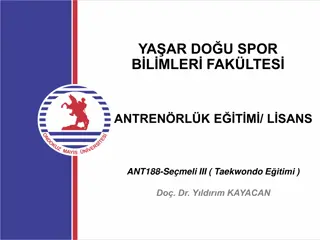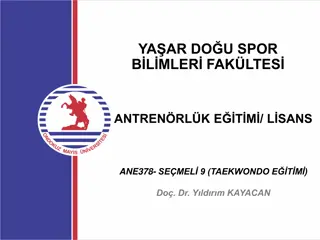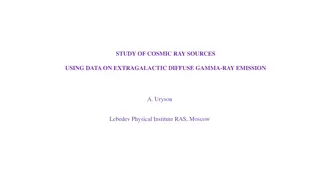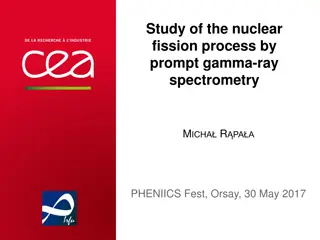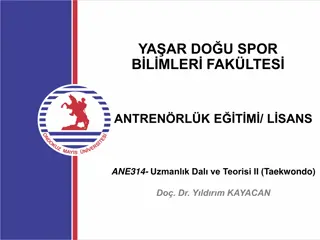Understanding Gamma Knife Stereotactic Radiosurgery
The Gamma Knife Stereotactic Radiosurgery is a precise and effective treatment method where highly focused radiation beams are used to target tumors and abnormalities in the brain. It does not remove the tumor directly but affects DNA, cell growth, and blood vessels. The procedure involves three main parts: 3D stereotactic localization, dose planning, and radiation exposure using advanced imaging techniques. The tumor's growth is halted, and benign tumors may disappear over time, while cancerous tumors can shrink rapidly post-treatment.
Download Presentation

Please find below an Image/Link to download the presentation.
The content on the website is provided AS IS for your information and personal use only. It may not be sold, licensed, or shared on other websites without obtaining consent from the author. Download presentation by click this link. If you encounter any issues during the download, it is possible that the publisher has removed the file from their server.
E N D
Presentation Transcript
History Equipment and its working Indications Results Complications
The Gamma Knife (stereotactic radiosurgery) in which narrow beams of highly focused and destructive dose of radiation is given in a single session using an external reference frame fixed to the head. Term introduced by Lars Leksell in 1951 (Professor of Neurosurgery, Karolinska University) 1967 , 1stGKRS installed by Leksell & Larsson at Stockholm (For treatment of intractable pain managements & functional procedure using 179 CO -60 source) 1975 , 2ndgeneration GKRS used at Karolinska institute using round collimetors (4,8,14,18mm) for treatment of vascular malformation & tumors Focal distance from radiation source to target is 40.3 cms
Four models are used Model U : uses a hemispherical array dose profile greater in superior / inferior extent model B/ C: uses circular array of radiation sources dose profile greater in right/left New model C: contain an automatic positioning system latest version (perfexion ):was first installed at Mayo Clinic in September 2007.
Radiation does not remove the tumor or tissue abnormality. Radiation distorts DNA (ionizing induces mutations and other forms of DNA damage & cell cycle arrest). Radiation induce apoptosis to proliferating cells. The cell lose its ability to retain fluids. For arteriovenous malformations, radiation induces the thickening and closing off the blood vessels.
Tumor loses its ability to grow Remains the same size Never grow again Benign tumors take up to 2 years to disappear Metastatic (Cancerous) tumors take only months to disappear
Three part of the procedure 3 D Stereotactic localization Dose planning- Most crucial Radiation exposure
Aim to place stereotactic frame such a way that lesion to be treated is located as close to 3-D frame centre as possible . Use imaging and 3-D mapping techniques to target tissue of interest Tomography Techniques: PET (CT) and MRI Good for tumor pathologies X-ray-based Techniques: X-ray and Digital Subtracted Angiography Good for vascular imaging
Gamma Plan 4.12 software used to plan GK treatment of a frontal lobe meningioma. Note abrupt fall off of radiation at tumor edge. The tumor volume is red and the yellow lines represent the 50% isodose curves.
Image transferred & using Leksell Gamma Knife 3-D planning software, a treatment protocol is planned Surgeon, radiation oncologist and radiation physicist decide dose plans different collimator sizes and added "shots required Tumors may not be exactly spherical Require additional "shots"
High dose delivered to tumor core Tumor tissue less oxygenated at center Normal surrounding parenchyma spared Dose most lethal when surrounding tissue receives a higher dose of radiation
Dose rate Volume of tumor- maximal tumor volume that could be radiated is around 25 cc Cranial nerves sensitivity Effect on surrounding vessels Usually not a limiting factor Endothelial damage in large vessels does not leads to thrombosis in most of the cases
Factors determining cranial nerve dysfunction Nature of the nerve -Optic and Acoustic Length of nerve irradiated Volume of nerve roots exposed Mechanical stretching of the nerve by tumor
Optic nerve- 8 Gy Cavernous sinus nerves- 30-40 Gy Trigeminal nerve- 10-25 Gy Facial nerve- 10-25 Gy Lower cranial nerves- 10-25 Gy Tishler CA, loeffler JS et al :Tolerance of cranal nerve to radiosurgery :Int J Radiate Oncol Biol Phys, 1193
Noninvasive method of treating inoperable lesions Eliminates the risk of open surgery patients experience little discomfort. Low immediate procedural morbidity Patients can immediately resume their previous activities Short hospitalization The lesion being treated receives a high dose of radiation with minimum risk to nearby tissue and structures
Delayed complication of radiation Use is limited to tumor located adjacent to critical neurovascular structure
Lesions characteristic small -less than 3 cms in diameter Larger not appropriate require two or more "shots radiation dose to surrounding brain is more - damage tissue Radiation Necrosis Geometrically Regular- spherical, ovoid or cylindrical is good irregular shaped i.e. star or crescent shaped- not good candidates Difficult to plan radiation dose volume or it deliver lethal dose of radiation to the surrounding brain
Tumors Acoustic neuromas Pituitary adenomas Meningiomas Skull-based tumors Meningiomas of cavernous sinus Chordomas and chondrosarcomas Craniopharyngiomas Metastases Gliomas and other primary intra-axial tumors Pineal tumors Haemagioblastoma Glomus tumors
Vascular abnormalities: Arteriovenous malformations Cavernous malformations Functional problems: Trigeminal neuralgia Parkinson s disease ( pallidotomy) OCD Radiosurgical thalamotomy For epilepsy Cavernous malformation Arteriovenous malformation Hypothelamic hemartoma -Mesial temporal epilepsy Ocular tumors Uveal melamona Orbital metastases Optic nerve sheath meningioma
First GKRS by Leksell and steiner, in 1969 Effect is either no further growth or slight diminution of tumor volume In past 25 years, results favoring GK as compared to microsurgery No reports of cancer being caused by radio surgery Tumor control rate : 93 - 98% Hearing preservation superior with Gamma knife as compared to micro neurosurgery. Rare loss of facial movement or sensation Most patients retain some hearing
Small tumors with maximum intracisternal diameter : < 3 cm Residual / Recurrent tumor after microsurgery In elderly population High risk patients refuse microsurgery. In younger subset, hearing preservation is an important issue Contraindication : Tumor causing mass effect on brain stem with clinical deficit
Marginal dose for small tumors -14 Gy medium tumors - 12 Gy large tumors -10 Gy Margin dose 11 to 15Gy at 50% isodose curve.
Procedure Death Cure/ Control Hearing Preservation Facial Nerve Preservation GK Radiosurgery 0% 70% 100% 90-96% Microsurgery 98% 1.5% 7% 63% Regis J,Delsanti C,Roche P-H,Thomassin J-M,Pellete W. Functional outcomes of radiosurgical treatment of vestibular schwannomas: 1000 successive cases and review of the literature.Neurochirurgie 2004:50(2-3):301-311 J. Neurosurg94(5):1091-1100,2002,Modern management of vestibular schwannomas
Earliest change includes loss of contrast or gadolinium enhancement, most marked in center of tumor Poorer response in NF-2-life long follow up required SRS high rate of tumor control, higher hearing preservation , low morbidity Initial loss of contrast enhancement may be followed by period of increased volume and dense enhancement Decrease in tumor volume with increased length of follow up- up to 90 % at 10 years Chopra R, Kondzoilka D,Niranjan A,Lunsford LD,Flickinger JC. Long term follow-up of acoustic schwannoma radiosurgery with marginal tumor doses of 12 to 14 Gy.Int J Radiat Oncol Biol phys 2007:68:845-851
Microsurgery is the initial treatment of choice First Meningioma radiated in 1975 GKRS used as an alternative to post operative radiotherapy for residual meningiomas Advantages include unique accuracy and precision ; minimizing risk
Indications primary treatment (for difficult to operate ) cavernous sinus / basal meningioma petroclival tumors of the posterior fosse Medical illness /advanced age For residual meningiomas Recurrent tumor after open surgery Contraindicated Tumor with symptomatic optic nerve or chiasmal compression optic nerve sheath tumor with preserved vision > 3 cms in diameter with mass effect
Mean dose to tumor margin :14 Gy Mean tumor volume: 7.4 ml mean 7.5 isocenter used Results 94% tumor control rate 10% edema risk Subsequent surgery - 5.2 %, Additional RT :2.9% Morbidity 7.7% Kondziolka,Niranjan A,long term result after radiosurgery for benign intra cranil tumors, Neurosurgery 2003, 53
SRS recommended mainly for Pilocytic astrocytomas located in thalamus, hypothalamus, brain stem, optic tract etc. Low grade gliomas (grade 2) are usually diffusely infiltrating hence role of radiosurgery limited for residual lesion Low grade glioma in medial temporal lobe is usually well circumscribed and amendable to SRS Two groups where it can be used patients with low Karnofsky's score well localized small lesions
Primary Low Grade Gliomas 95% response rate. 10-year follow-ups in most patients treated show no evidence of residual tumor Kida Y,Kobayashi T,Mori Y,Gamma knife radiosurgery for low-grade astrocytomas:results of long term follow-up. J Neurosurg 2000:93
Cytoreduction followed by GK MR scan within 48 hours of surgery residual, enhancing tissue is boosted with GK followed by conventional radiation therapy recurrence treated with GK, if tumor nidus is small High grade gliomas are usually bulky tumors; SRS again has a limited role
Controlled studies need to be completed to conclusively demonstrate the role of GKRS Recent studies indicate radiosurgery is useful in extending survival in patients with recurrent glioblastoma Median tumor progression free interval of 12 months Hsieh PC et al, Adjuvant Gamma Knife stereotactic radioosurgery , treatment option for recurrent GBM, Neurosurgery 2005,57
Metastatic tumors are usually well circumscribed; hence amendable to GKRS GKRS used in two forms As local boost in combination with WBRT As exclusive primary therapy As a primary therapy can be used in patients with low Karnofsky s score where WBRT is not desirable Dose recommendations adjunctive therapy 15-20 Gy primary therapy 25-30 Gy
Surgical removal + radiation benefits patients quality of life and survival must control primary tumor first Gamma Knife radiosurgery As effective as open surgery combined with brain radiotherapy J Neurosurgery / Volume 93 / Dec 2000 Effective even for tumors relatively resistant to external beam radiation therapy In selected individuals, whole brain radiotherapy not necessary Some multiple brain metastases are also candidates for GK J Neurosurgery / Volume 93 / Dec 2000 Recurrent or new tumor deposits can be retreated by GK
Success rate up to 90% reported Increase in tumor volume in some cases can be due to radionecrosis Recurrence rate is 7-15% Vs 20% for craniotomy + WBRT; hence Gamma knife superior Best results are obtained in patients with Melanoma and Renal cell carcinoma Results are poor with Bronchogenic carcinoma Hence, SRS recommended as primary modality for metastasis except in very large tumors Hasegawa ,et al,Brain metastasis treated with radiosurgery alone, an alternative to WBRT,Neurosurgery 2003,52
Best managed by microsurgery Gamma Knife radiosurgery useful in recurrent residual tumors, especially in the cavernous sinus. Excellent preservation of cranial nerve and pituitary function.
Goal :to stabilize or reduce adenoma volume SRS indicated: failure of total resection / parasellar region recurrence after surgery and radiotherapy Dose required is less as compared to functional tumors Edge dose to tumor ranges from 10-15 Gy Dose to optic apparatus should be kept below 8 Gy Excellent tumor control rate 93% ( 68 - 100 % ) Relatively safe no neuro-opthalmological complications reported 1 case of pan- hypopituitarism reported Sheehan JP ,Kondziolka,Radiosurgery for residual/recurrent nonfunctioning pituitary adenoma ,J Neurosurgery 97,2002
Complete surgical resection not possible in many cases because of frequent parasellar growth SRS indicated in these cases Also used as an initial modality by some and in recurrence after surgery Edge dose to tumor ranges from 10-25 Gy In 70% cases GH levels fall below 5 ng /ml Pollock BE Radiosurgery of GH producing pituitary adenoma :factor associated with biochemical remission ,J Neurosurgery 2007 ,106
Microsurgery considered gold standard for microadenomas - excellent results SRS indicated - Recurrent cases - Inaccessible tumor dose to tumor margin 20 Gy. Normal 24 hour UFC:63% at 1 year Hypocortisolism/recurrent disease not correlated with radiation doses. Tumor volume decreased in 73% cases not significantly correlated with endocrine outcome Sheehan JM.,Vance ML,Sheehan JP,et al Radiosurgery for cushing`s disease after failed transphenidal surgery. J.Neurosurg 93(5):738-42 2000
GK - primary - unsuccessful surgery (residual ) - failed medical treatments Mean dose to tumor margin 13-30 GY Endocrine cure rate 52 % Remission rate poor in pt receiving antisecretory medication at time of GK Pan L,zhang N,Wang EM.Wang BJ,Gamma knife radiosurgery as a priary treatment for prolactinomas.J Neurosurgery 2000:93
Complete surgical resection not possible Multimodality therapeutic approach -Surgery + post op radiotherapy -Stereotactic cyst aspiration& injection of radioactive Yttrium-90 - GKRS + Stereotactic single dose radiation Chiou SM,Lunsford LD,Niranjan A,et al:Steriotactic radiosurgery of residual or recurrent craniopharygioma, after surgery,with or without radiation therapy.Neurooncol 3:159-166,2001.
GKRS used Primary treatment adjunctive treatment alone combining with intralesional brachytherapy Salvage treatment for recurrence. Optimum dose to achieve local control was 12 Gy.(10 20 ) Tumor control: 79%, complete response:19%, at 65 months mean follow-up. Results are better with squamous histology as compared to adamantinomatous type. Kobayanshi et al. Japan Long-term results of Gamma Knife surgery for the treatment of craniopharyngioma in 98 cinsecutive cases.J Neurosurg 2005:103(6 suppl)
Role of GKRS remains controversial Indication Elderly patients with symptomatic tumor Residual / recurrent tumor Smaller tumors Contraindication Young patient with large tumors causing significant mass effect Patient with catecholamine secreting tumor Tumor growth control rate of 94% Mean dose of 16.4 Gy. Margin dose 16.4 Maximum dose 30 Mean follow-up 46 months. Tumor control rate : 94%
Low morbidity-zero mortality. Hearing lose: 54% Lower cranial dysfunction is extremely rare Nausea,vomitting and dizziness/vestibular dysfunction Transient facial or glossopharyngeal neuropathies Neither target volume nor the radiation dose associated with the incidence of cranial neuropathies. Severe vertigo after radiosurgery
Gold standard treatment surgical resection of the solid components GKRS can be given to solid portion ,with max dose 28 - 60 Gy and peripheral dose 11 20 Gy Tumor size Decrease in size - 70 % No change in size 30 % Niemela M young J et al ,Gamma knife radiosurgery in 11 Hemangioblastoma,in 7th international meeting fLeksell Gamma Knife Society,1995
Rare skull base tumors Both highly invasive locally Challenges to treat due to their invasiveness, proximity to vital structure Post op GKRS modest reduction in tumor size and long term survival Muthukumar N,Kondzoilka D,Lundsford LD,et al: Stereotactic radiosurgery for chrdoma and chondrosarcoma: Further experiences. Int J Radiat Oncol Biol Phys 41:387-392,1998.
Technical issue Indication: Pilocytic astrocytomas / low grade glioma High grade glioma Medulloblastomas Ependymomas Craniopharyngioma Pituitary Adenomas Pineal region tumors Gangliogliomas Choroid plexus papillomas Neurocytomas
No initial effects of radiosurgery Few patients have experienced seizures almost always with established seizure disorder adjust anticonvulsant prior to treatment Local pain in the scalp simple, oral pain medication
-Brain edema cells lose ability to retain fluid, swelling within the adjacent brain Rx -oral steroids/ self-limiting Psychological side effects: loss of memory, decreased cognitive abilities Cranial nerve dysfunction double vision /visual loss facial numbness, weakness hearing loss Rare with modern gamma ray doses
Radiation Necrosis radiosurgery turns a live tumor into a dead tumor large tumors are not good candidates ?? risk of radiation necrosis increases with size dead tissue cleared from brain by an inflammatory reaction bigger the mass of dead tissue = greater the inflammation high doses of steroids 6 and 18 months after procedure Sometimes open surgery to remove dead tissue
MR/CT imaging every 3 months to every year assure control of tumor Arteriovenous malformations-MR angiograms Follow-up protocols vary from center to center







